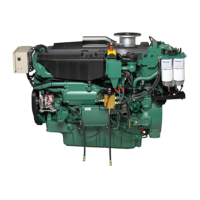Applying load
When the engine has reached operation tempera-
ture, bring the engine to operating speed and apply
the load gradually.
During operation make sure that:
1. No engine related alarms occur.
2. There are no visible leaks of fuel, lube oil, coolant
or exhaust gas
3. No abnormal noise or vibrations occur.
4. The color of the exhaust gas is normal.
5. Instrument readings are the normal, refer to sec-
tion ”Technical data”
Running in
The engine must be “run in” during the first 10
hours of operation as follows:
Run the engine under nor mal operation. Do not run
it at full power except for short periods. Never run
the engine for long periods at constant rpm during
this time. A high consumption of lubricant is nor mal
during the running in period. Therefore, check the oil
level more often than recommended. The prescribed
warranty inspection “First Service Inspection” must
be carried out during this first period of operation. For
more infor mation: See Warranty and Service Book.
Forced propeller rotation
When the vessel is towed or anchoring in strong
currents, the propeller can make the propeller shaft
rotate even though the engine is stationary. This may
damage the marine gear.
Manoeuvring
The marine gear must be engaged at low idling
speed. There must be a brief pause after engaging
gear before increasing the engine speed. Wait for
approximately two seconds to ensure that the gear
clutch has engaged properly.
Forward–Reverse
1. Slow the engine speed to idling and allow the
vessel to loose most of its speed.
2. Move the lever to neutral.
3. Move the lever to reverse.Wait for approximately
two seconds and then increase the engine speed
gradually.
IMPORTANT! A direct forward–reverse maneu-
ver can damage the marine gear and engine. It
is necessary to allow the vessel to lose most of
its forward speed before engaging reverse. Oth-
erwise there is a risk of the propeller windmilling
which might cause the engine to stop and start
rotating in the wrong direction. This may cause
serious engine damage.
45
Operation

